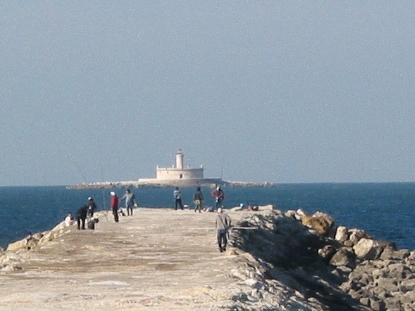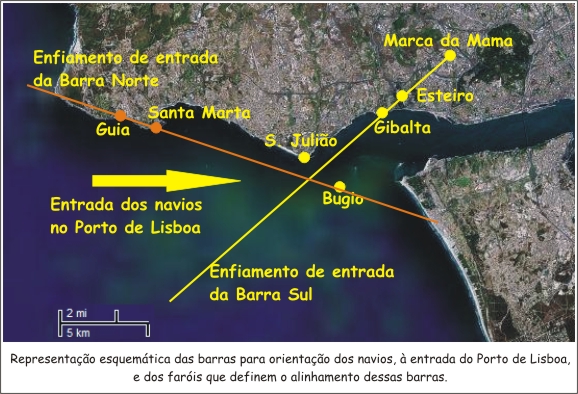Faróis de Portugal
Lighthouses in Portugal

PT: A ideia original da GeoDuplaP&F pretende com este conjunto de caches divulgar os faróis que existem em Portugal, e dar a conhecer a sua localização e informações sobre cada um deles.
EN: the original idea of GeoDuplaP&F with this set of caches is to show the lighthouses that exist in Portugal, and to show the location and information of each one of them.

Origem dos Faróis
Origin of the Lighthouses
PT: Desde a antiguidade que se torna necessário uma sinalização que avise os navegadores dos pontos da costa, seja para sinalizar esses mesmos pontos, seja para sinalizarem passagens seguras para os navios.
EN: Since the earlier times it is necessary to have signalling to show to the navigators the points of the coast, either to signal these same points, either to signal safe ways for the ships.
PT: O farol mais antigo que se conhece é o Farol de Alexandria, com 135 m de altura, uma das Sete Maravilhas do Mundo Antigo. Este foi construído por Ptolomeu Filadelfo, por volta de 300 a.C., na ilha de Pharos, derivando daí o nome de "Farol". Conseguia-se ver a sua luz a 100 km de distância. Foi destruído por um sismo em 1326. Ao longo dos tempos, os Fenícios, os Gregos e principalmente os romanos construíram diversos faróis em toda a costa marítima, dos quais o mais antigo que se encontra em funcionamento é o da Torre de Hércules, na Corunha (Galiza, Espanha), construído cerca de 100 d.C. e reconstruído em 1663.
EN: The most ancient known lighthouse is the Lighthouse of Alexandria, 135 m height, one of the Seven Wonders of the Ancient World. It was built by Ptolomeu Filadelfo, by 300 a.C., in the island of Pharos, from where came the name for Lighthouse in latin languages, i.e. "Farol" in portuguese, "Phare" in french. Its light could be seen at 100 kilometers. It was destroyed by an earthquake in 1326. From then, the Greeks and the Romans had built several lighthouses in all the sea coast, the older of which we can find today still functioning is the Lighthouse in the Hercule Tower, in A Coruña (Galiza, Spain), built about 100 AD and rebuilt in 1663.
Os Faróis em Portugal
The Lighthouses in Porugal
PT: Em Portugal, antes do séc XVIII não havia quaisquer faróis a cargo do estado, sendo muitas vezes os particulares que acendiam fogos junto da costa para servirem de aviso aos navegadores portugueses. O primeiro farol que existiu na costa portuguesa foi no Cabo de S. Vicente, na torre do Convento de S. Francisco, em 1520. Os primeiros faróis a cargo do Estado foram construídos em Cascais (Guia) e no Porto (N. Sra. da Luz, em 1761). Nas ilhas dos Açores e Madeira, a primeira construção de um farol data de 1870, o farol da ponta de S. Lourenço, e no Porto Santo em 1900.
EN: In Portugal, before the 18th century, there were no lighthouses coordinated by the government. Many times the inhabitants lit fires next to the coast to help the Portuguese navigators. The first lighthouse that existed in the Portuguese coast was built in Cabo de S. Vicente, in the tower of the Convento de S. Francisco, in 1520. The first lighthouses constructed by the government was in Cascais (Guia) and in Porto (N. Sra. da Luz, in 1761). In the islands of Açores and Madeira, the first lighthouse dates from 1870, the lighthouse of the Ponta de S. Lourenço, and in Porto Santo in 1900.
PT: Por volta de 1900 a gestão dos faróis passa do Ministério das Obras Públicas para o Ministério da Marinha, onde se mantém até hoje.
EN: By 1900 the management of the lighthouses goes from the Ministério das Obras Públicas to Ministério da Marinha, where it is until today.
PT: Esperamos que gostem das caches e que visitem os faróis depois (ou antes) de as visitarem.
EN: We hope you enjoy the caches and you visit the lighthouses after (or before) the caches.
Mais informações / More informations:
Farol do Bugio, na Fortaleza de S. Lourenço
Bugio Lighthouse in S. Lourenço Fortress
| Local / Location: |
Foz do Tejo |
| Altura / Tower height: |
14 m |
| Altitude / Place height: |
28 m |
| Luz / Light: |
LI Vd 5s |
| Alcance / Reach: |
9 M |
| Óptica / Optics: |
Omnidireccional 300 mm |
| Ano / Year: |
1775 |
PT: No séc. XVI, ainda antes do tempo do domínio espanhol, foi decidida a construção de um forte naquele local (Fortaleza de São Lourenço da Cabeça Seca) para servir de defesa à entrada no Tejo, com diversas peças de artilharia. A construção terminou apenas no reinado de D. João IV, quase um século depois.
EN: In the 16ª century, before spanish kings, it was decided the construction of a fortress in that place (Fortaleza de São Lourenço da Cabeça Seca) to be used as a defense to the entrance in Tejo river, armed with some artillery. The construction finished only in the reign of king D. João IV, almost a century later.
PT: Sendo destruído pelo terramoto de 1755, foi reconstruído e instalado ali um farol, por decreto do Marquês de Pombal, em 1775.
EN: Destroyed the earthquake in 1755, it was reconstructed and installed there a lighthouse, from a decreet of Marquês de Pombal, in 1775.
PT: Após um melhoramento do farol, passou em 1865 a ser composto por 16 candeeiros que produziam uma luz branca. 30 anos depois passou a funcionar a petróleo produzindo clarões vermelhos num período de 20 segundos, além da luz branca. Em 1933 passa a funcionar a gás, e em 1959 com uma lâmpada eléctrica.
EN:After an improvement of the lighthouse, in 1865 it was changed to 16 oil lamps that produced a white light. 30 years later it started to use oil, producing red flashes in a period of 20 seconds, beyond the white light. In 1933 started to use gas, and in 1959 with an electric light bulb.
PT: Em 1981 foi dotado de um automatismo de rotação e de detecção de nevoeiro, monitorizado em Paço de Arcos. Deixando de ter faroleiros em 1992, passou em 1994 a funcionar com energia solar.
EN: In 1981 it was endowed with an automatism of rotation and fog detection, monitorized in Paço de Arcos. Having no more workers in 1992, in 1994 started to function with solar power.
PT: Em 2000 teve obras de fundo, devido ao estado degradado em que se encontrava por causa da acção do mar.
EN: In 2000 it had great maintenance work, because of the degraded status it was, due to the action of the sea.
A Entrada no Rio Tejo / Entering in Tejo River
PT: Este farol é, a par com o farol de S. Julião, uma das duas torres que define a entrada dos navios no Rio Tejo e no Porto de Lisboa, auxiliados por outros 5 faróis. Veja um esquema aproximado dos alinhamentos entre esses faróis, e a seguir as caches que existem nos mesmos faróis.
EN: This lighthouse is, with S. Julião Lighthouse, one of the two towers that define the entrance of the ships to the Tejo River and Lisboa Harbour, helped by other 5 lighthouses. Next you'll see a scheme of the alignment of these lighthouses and the caches you can find on these lighthouses.

Caches nos faróis representados / Caches found in those lighthouses:
A Cache / The Cache
PT: Esta é a segunda versão da cache do Farol do Bugio, porque a primeira teve que ser retirada de onde estava. Podem vê-la aqui:
EN: This is the second version of the cache, as the first had to be removed. You can see it here:
PF05 - Faróis de Portugal - Bugio
- É um local de onde se consegue uma boa perspectiva sobre o farol / It's a place where you have a nice view over the lighthouse
- É o local onde já existiu uma passagem pela areia até ao farol, antes de aquele local se ter transformado numa ilha / It's a place where long ago there was a way by the sand to reach the lighthouse, before it was turned into an island.
Outras Caches nas Proximidades / Other caches nearby
